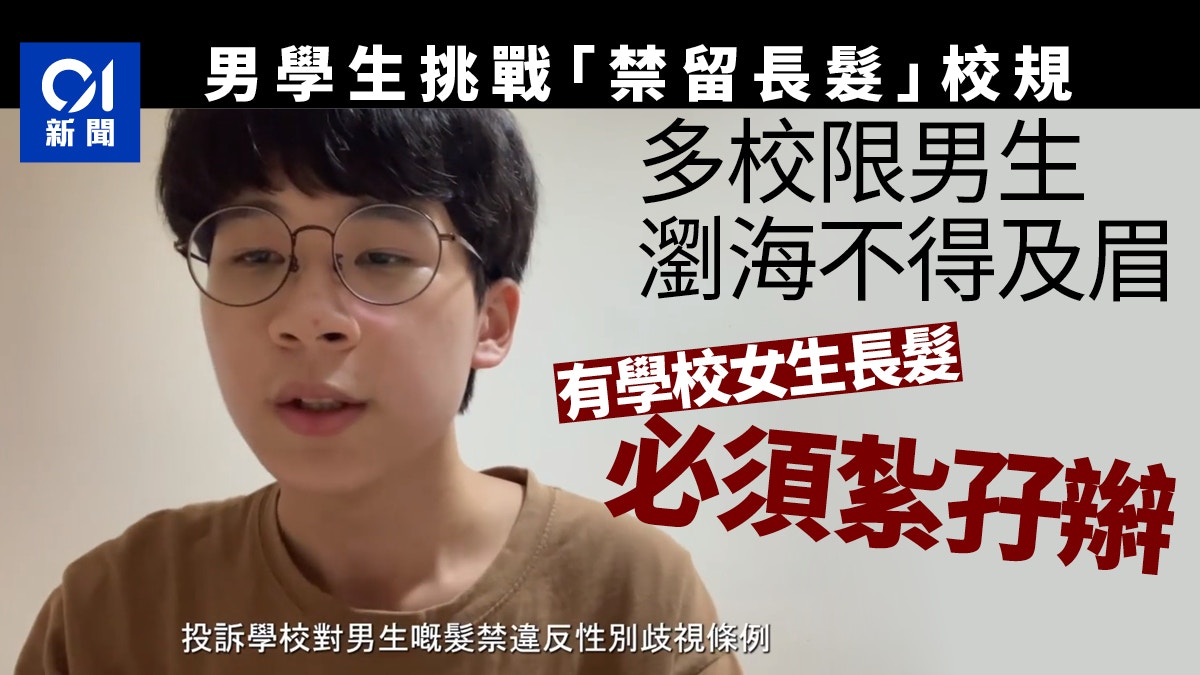A Form 5 boy surnamed Lin from Tung Wah Group of Hospitals Wong Wat Nam Middle School said earlier that he was deprived of participating in school activities or faced suspension due to his long hair.
After he succumbed to the haircut, he formally complained to the EOC, claiming that the school's ban (forbidding male students to have long hair) violated the sex discrimination regulations. He thought the school rules were outdated, and the complaint was accepted by the EOC.
Check the school rules of different local schools. The school rules of many schools specify that the hair of male students should not be too long. For example, the temples should not exceed the earlobes, the bangs should be higher than the eyebrows, and the tail of the hair should not be attached to the collar. There are also corresponding school rules, such as ponytails or braids for long hair.
According to the EOC Guidelines, schools can decide whether to formulate school uniforms and related rules, but it also states that uniform rules should be formulated with an open attitude, to avoid gender stereotyping, and uniform standards should be applied equally to boys and girls.
The male student posted a short video on the Internet a few days ago. He believed that the school used the reputation of the school as an excuse to prohibit boys from having long hair. He pointed out that the statement was full of contradictions and prejudices. Students wash up every day before returning to school, so the argument is not valid, and they even ask: "Girls also have long hair, isn't it good?"
The male students said they had formally lodged a complaint with the EOC, claiming that the school’s ban (forbidding male students from having long hair) violated sex-discrimination regulations and that the school’s rules were outdated.
The EOC replied that the principles of confidentiality and need-to-know must be adhered to when dealing with enquiries and complaints, and therefore will not disclose whether certain enquiries, complaints or related details have been received.
When the school responded to other media inquiries, it confirmed that the EOC was involved in the case.
▼The opening day of Ho Man Tin Chuangzhi Middle School▼
+7
The reporter looked through some school materials on the Internet that have public school rules, and all of them have certain requirements for hairstyles, such as marking that hair cannot be dyed, electric hair, etc., and the hairstyle must be neat and tidy.
Take Diocesan Boys' College as an example, students must have neat hair, natural hair color, bangs should not reach the eyebrows, and the temples should not exceed the earlobes.
La Salle College has similar requirements and emphasizes hair length and collar.
Co Fung Middle School (hosted by Sik Sik Yuen) further mentioned that students are not allowed to grow beards, and that the length of the ear temples should only reach the middle of the ears, and emphasized that products such as hair paste should not be used to fix the hairstyle.
School skirts should be longer than the knees
For female students, although long hair is allowed, it is generally also required to be neat and must be tied in a braid. Taking True Light Girls’ Academy as an example, it is also not allowed to dye or curly hair. Short hair should not cover the collar; long hair must be tied braids, and must use black or dark blue elastic.
For school uniforms, school skirts must be at least 2.5 cm below the knee.
The Sheng Kung Hui Tsang Shiu Tim Secondary School in Shatin mentioned that if you have long hair that reaches your shoulders, you should wear a ponytail and keep your hairstyle neat.
In addition, for school uniforms, the length of the skirt must reach the knee, and white underwear should be worn under the school skirt.
Director of Education Cai Ruolin (file photo / Photo by Law Kwan-ho)
In response to the school uniform controversy, Secretary for Education Cai Ruolin pointed out that every school has its own culture. In teaching, in addition to knowledge and skills, attitudes and values are also important. Therefore, schools will set up a school based on the values education of students or their desired school ethos. There are corresponding school rules.
She went on to point out that the "School Administration Handbook" clearly sets out the guidelines for school rules, and I believe the school will handle it professionally.
According to the School Administration Manual, school rules must be simple, clear, reasonable, designed to educate and protect students, and enforced fairly and consistently.
When formulating rules on school uniforms, schools should refer to the "Racial Equity and School Uniforms" guidelines issued by the EOC.
While the majority of the guideline focuses on school uniforms, there are also references to student grooming, such as having long hair tied up, as appropriate rules.
However, the text also mentions gender equality, and believes that the school should formulate uniform rules with an open attitude, avoid gender stereotyping, and emphasize that uniform standards should be applied equally to boys and girls.
Form 5 students complained to the EOC about sex discrimination Cai Ruolian said there were guidelines for schools to deal with boys’ dissatisfaction with being banned from school Leung Kwok-hung challenged similar systems and finally won the case and the result was not as expected sex discrimination








